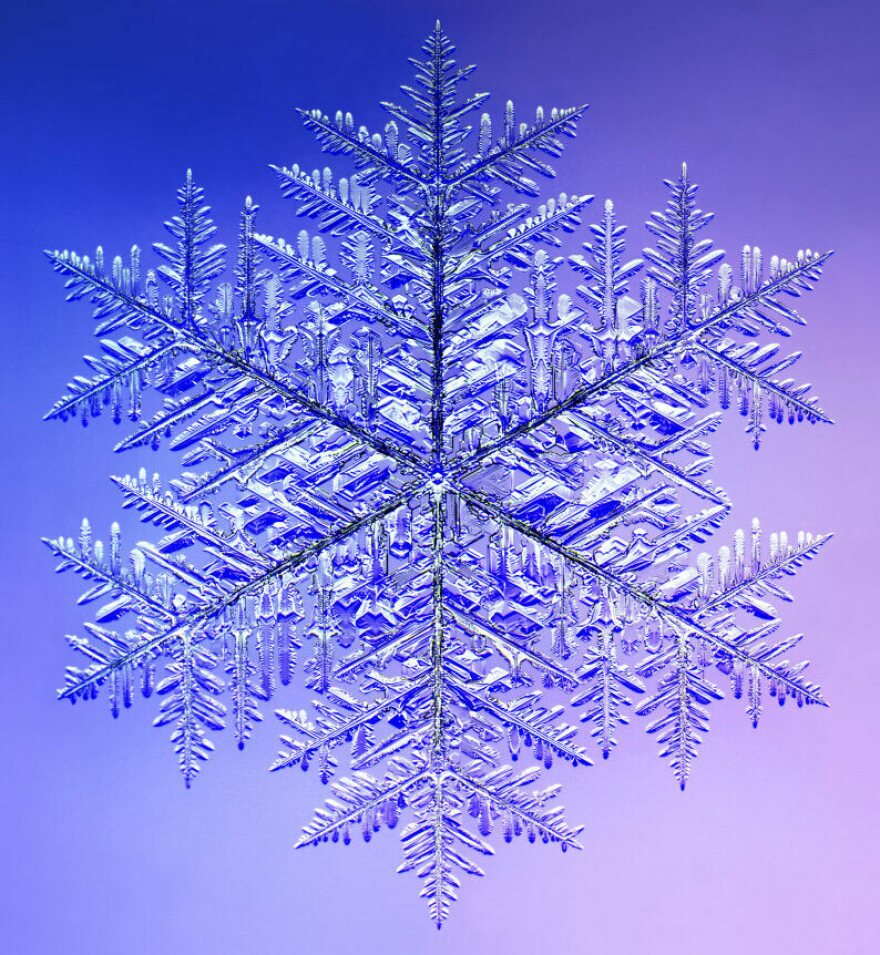Here's a question to ponder during these cold, wintry days: How big can snowflakes get?
Part of the answer depends on what you mean by the word "snowflake." The other part of that answer depends on who you ask.
If you consult the Guinness World Record keepers, they say that the "largest snowflake" is one that fell near Missoula, Montana in 1887. It reportedly was 15 inches in diameter and 8 inches thick.
But that claim used to really bug Kenneth Libbrecht, a Caltech physicist with a special interest in snow.
"There's a little problem with the language," says Libbrecht. "When people hear 'the world's biggest snowflake,' they always imagine a snow crystal, which is a different beast entirely."
A snow crystal with six-fold symmetry is the kind of snowflake you might cut out of folded paper with scissors.
But the word "snowflake" also can refer to white puffballs that drift down from the sky, which are made of many individual snow crystals that have collided and gotten entangled.
So about six months ago, Libbrecht contacted the folks at Guinness World Records and basically told them, look, your snowflake record is potentially confusing.
He suggested adding an additional record, for the 'largest individual snow crystal.'
And he had a contender for that title: a snow crystal he photographed twenty years earlier.
Libbrecht has long photographed naturally occurring snow crystals, even as he has made a name for himself generating snow crystals in the lab. The largest one he ever made was about an inch across, he says, but it wasn't pretty, and was barely hanging together as it started to fall apart under its own weight.
The biggest natural one he ever saw fell on December 30, 2003, when Libbrecht was in Ontario, Canada and the conditions were just right — almost no wind and temperatures around 5 degrees Fahrenheit.
"All of a sudden, just these really large flowers just came falling out of the sky," he says. "They were very noticeable, because they were just gigantic."
Normally, a decent-sized snow crystal is around 2 millimeters across, says Libbrecht. These were about five times bigger, and he rushed to take photos.
"They only fell for like ten minutes," he says, "and I managed to get a really good one."
He photographed a beautiful crystal, 10 millimeters wide — that's a centimeter, or about a third of an inch.
It's the biggest one he's ever heard of, and Libbrecht says he knows most of the small community that seriously pursues snow crystal photography.
He told the Guiness World Record folks that even if this snow crystal wasn't the biggest, "it would be fun. People might now be inclined to look around and find a bigger one."
What's more, it could help clear up what their 'largest snowflake' record really meant.
The record keepers ultimately agreed to his proposal, and now Libbrecht's snow crystal record is listed alongside the snowflake one from 1887.
But researchers who study big puffy snowflakes, the kind that are clusters of many snow crystals, have their own doubts about that 19th century claim.
"I must admit I'm a bit skeptical about it," says Sandra Yuter, a meteorologist with North Carolina State University.
She doesn't want to say it could never happen. "This is one of the issues in science," she says. "You can always get outliers."

She says individual snow crystals initially form high up in a snow storm, which can be around six kilometers tall. The crystals start to drift down at a speed of about a meter per second, so it takes more than an hour for an entangled crystal to travel from the top of the storm to the ground.
A lot can happen during that hour. The crystals get blown around and encounter other crystals that formed at different temperatures and conditions. They all glom together into a flake that can get bigger and bigger.
Eventually, though, the flake hits the ground, which means there's only a limited amount of time for snowflake growth.
To get a snowflake as big as the one that supposedly fell in 1887, the weather conditions would have to be pretty unusual, says Yuter, and there's no photographic evidence of that behemoth.
Yuter is an expert in photographing the intricate gatherings of snow crystals that fall as flakes, using a special contraption equipped with motion sensors and cameras to capture what our eyes can't.
"One of the interesting things about snow to me is it's falling just fast enough that we can't, as humans, see it very well. We sort of get the impression," she says. "And so, you know, we're using this technology to kind of take a snapshot and get a good picture of it."
The pictures show that each falling snowflake has its own delicate geometry. It's a jumble of many, many individual snow crystals with different shapes ranging from needles to little balls.
The diverse shapes are loosely entangled in a precarious, three-dimensional structure that tends to be elongated rather than spherical. And the tiny crystals are just barely stuck together, says Yuter, so the smallest poke would make the whole thing fall apart.

That could help explain why,while the Guiness records would have us believe in snowflakes the size of a dinner plate, the biggest she's ever photographed was 35 millimeters across, or about an inch and a half.
Yuter says that she and her colleagues have photographed more than 100,000 snowflakes over the years. It never gets old.
Looking through all the photos can be mesmerizing, she says. "You can really get into it — the beauty of it, and the complexity of it, and I guess the wonder," says Yuter. "That's one of the cool things about snowflakes; they're wonderful."
Copyright 2024 NPR. To see more, visit https://www.npr.org.



